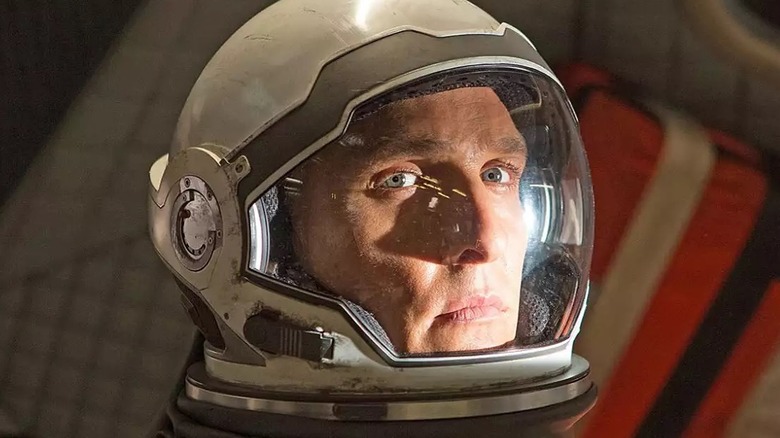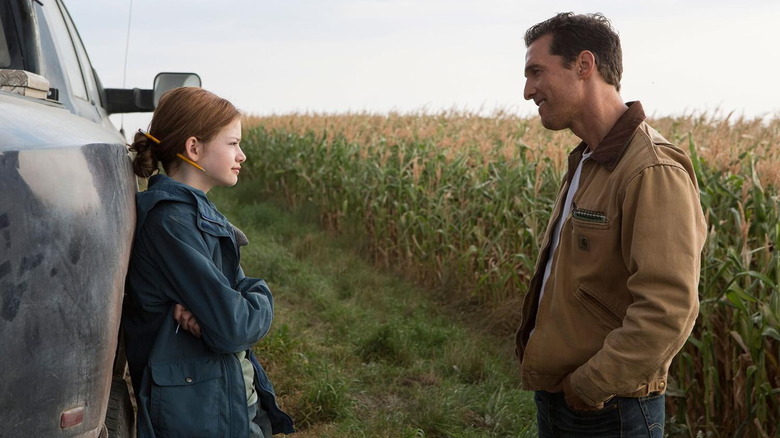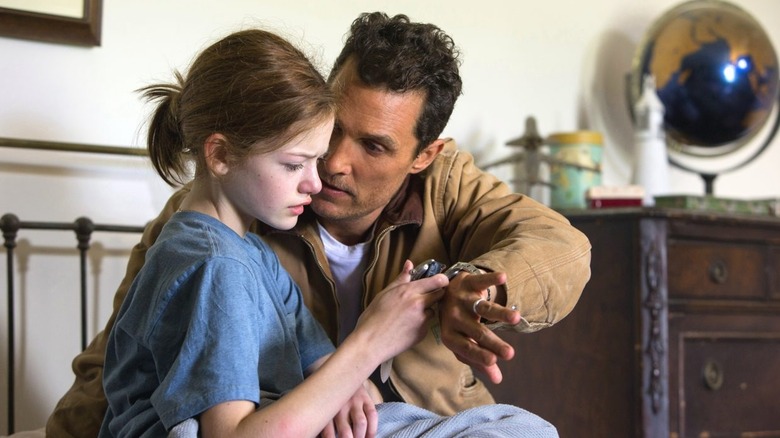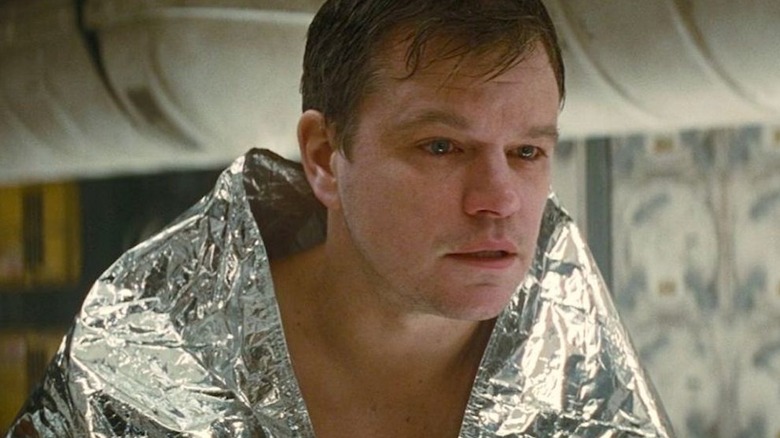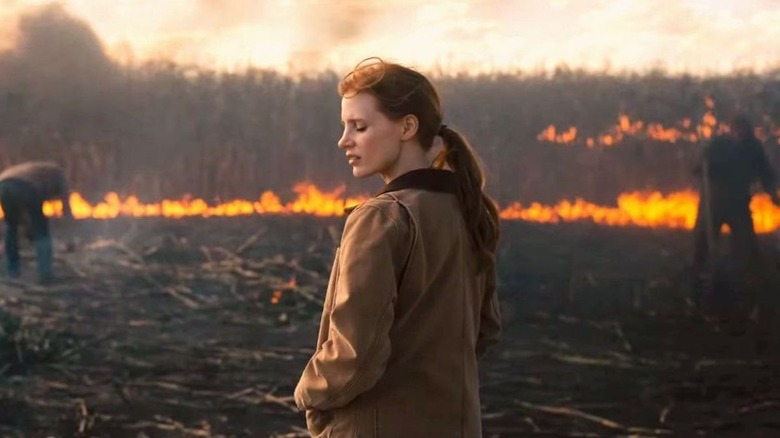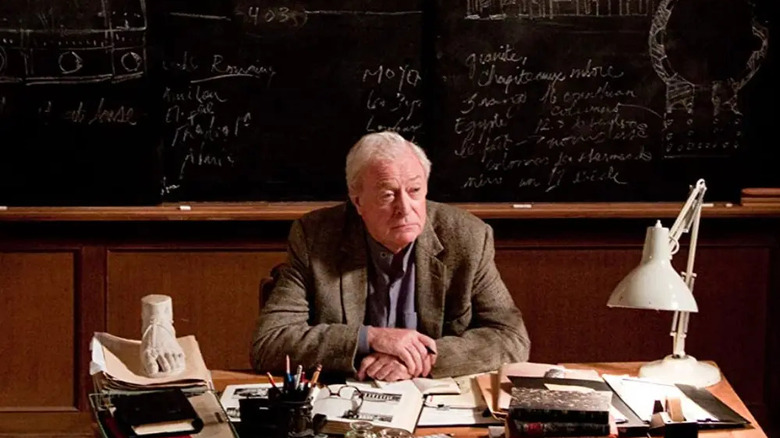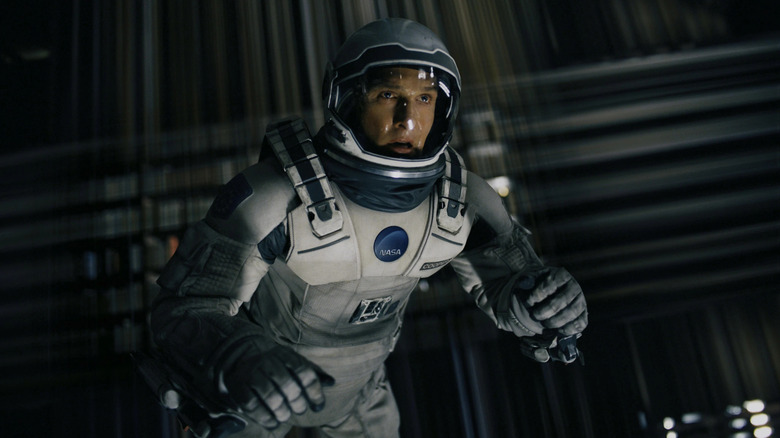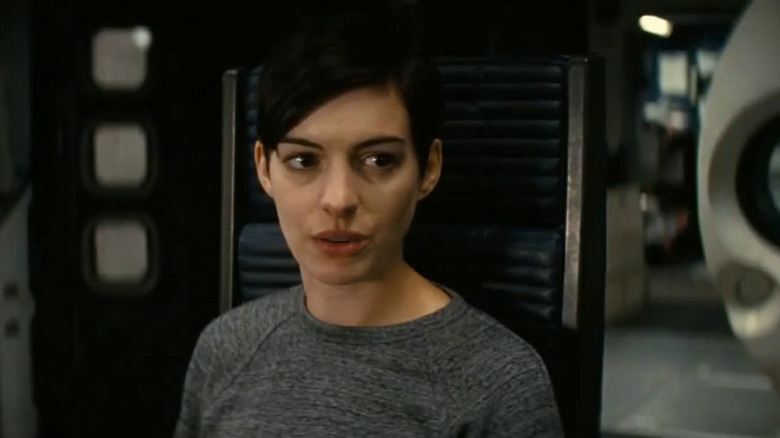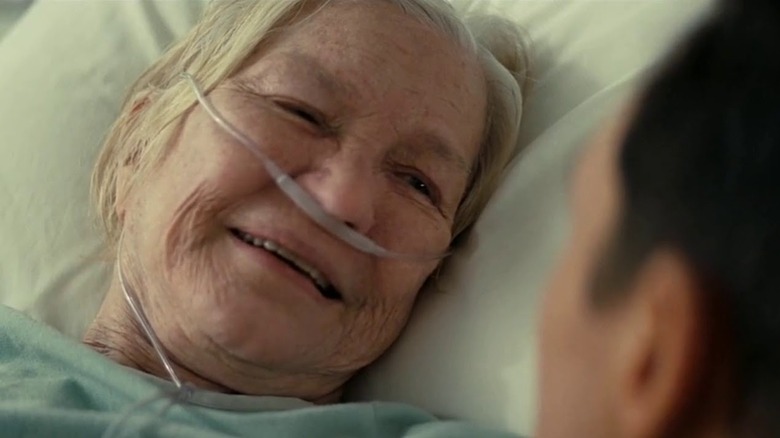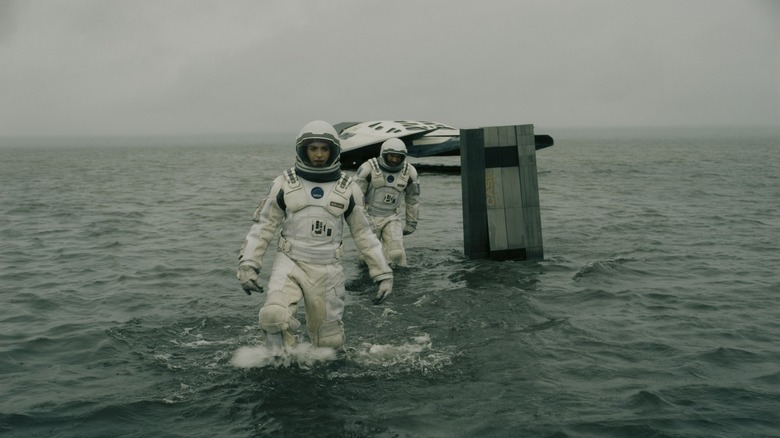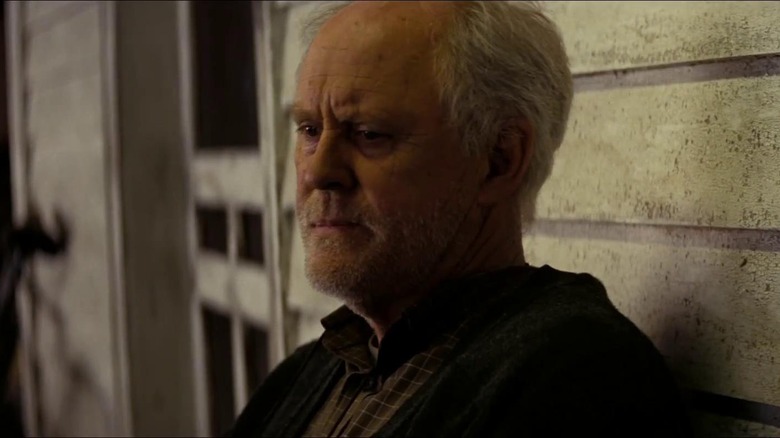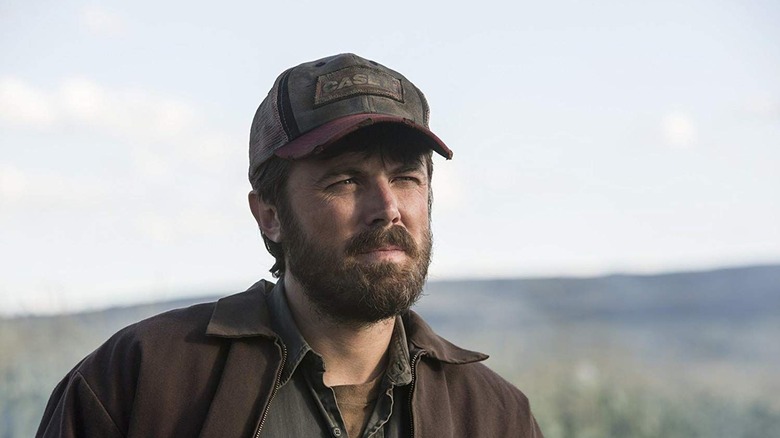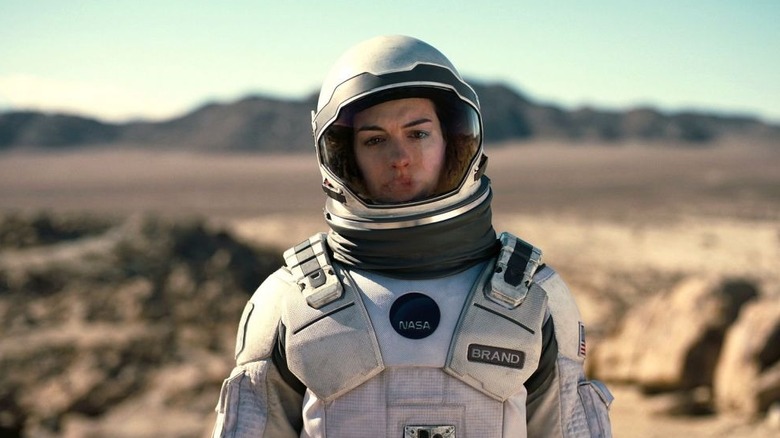Interstellar's Most Confusing Moments Explained
Nearly a decade after its release, Christopher Nolan's "Interstellar" remains one of the filmmaker's biggest enigmas. This sci-fi epic about space travel is Nolan's most tender movie, openly about how love transcends all dimensions.
In "Interstellar," the Earth's natural resources are dying out, and humans must find a new planet to inhabit. Cooper (Matthew McConaughey) is a farmer with a background as a pilot who journeys to outer space to find a new home alongside Dr. Brand (Anne Hathaway) and a team of the last remaining astronauts. Meanwhile, back on Earth, his daughter Murph (Jessica Chastain) tries to solve the equation that will allow humans to leave the increasingly uninhabitable planet.
At times, it can be corny, but there is far more to "Interstellar" than meets the eye. However, that complicated nature can lead to many viewers' convoluted explanations of Nolan's grand ideas, making it one of the director's most perplexing movies. Here are the most confusing moments from "Interstellar" explained.
What is the gravity equation?
Professor Brand (Michael Caine), the father of astronaut Brand, dedicated his entire life and career to solving the gravity equation. Once he passes away, Murph takes on the responsibility of searching for the answer, but throughout the movie, it is never made clear what exactly they have been after. What is apparent is the purpose: once this mysterious equation is solved, humans will be able to use gravitational anomalies to manipulate gravity and safely get everyone off the planet with an ample supply of food, water, and fuel. The snag in the plan is that data from inside a black hole is needed to complete it. No one has ever seen inside a black hole so there was no way to get the data... until Cooper.
For obvious reasons, the movie couldn't get into the gritty scientific details of the fake equation, but what is important to know is that anomalies are crucial to the solution, and a black hole is the biggest anomaly of all. When Coop goes inside Gargantua at the end of "Interstellar" and transmits that data to Murph, she is finally able to solve the equation and save humanity.
Who is the ghost at the start of the movie?
The opening 30 minutes of "Interstellar" are confusing the first time through (and perhaps even after a repeat viewing). During that first act, you might be left wondering what this whole ghost story has to do with space travel and saving the human race. Well, as it turns out, everything. By the end of the movie, you will learn that Cooper is the ghost — or gravitational anomaly — trying to communicate with Murph through time while he is in the black hole tesseract, which allows him to perceive the five dimensions (don't worry, there will be more on that later, as the tesseract itself is a confusing aspect of the film).
When Coop is inside the tesseract, he realizes he can communicate with young Murph (Mackenzie Foy) via the bookshelf. We see the mirror image of an earlier scene where the "ghost" spells out the word "stay" through Morse code, and we learn that it is actually Cooper trying to convince himself not to leave Murph behind. At this point in the story, Cooper regrets ever leaving and tries to change the past, although it cannot be done. Coop can travel through the dimension of time, though, and he uses the bookshelf to communicate the solution to Professor Brand's formula when she visits the house in the present timeline.
Why is the watch Coop leaves for Murph so important?
Perhaps the single most confusing moment of "Interstellar" is the significance of the watch that Cooper gives to Murph when she is a child. In a moment of anger, she breaks it, but it stays in the house for years. When Cooper goes into Gargantua, the black hole, he winds up in the tesseract. Here, he sends Murph a coded message that solves the gravity equation. He does this by using gravity — which is a force that transcends time, according to the film — to move the hands of the watch and communicate with Murph in Morse code. By manipulating gravity, he can cause the broken watch to tick in code and transmit the information to save humanity.
There are many theories as to how exactly this works because the film never explains it cleanly. Since time isn't passing for Coop, he can potentially spend as much time as he needs — perhaps even years — transmitting what he needs Murph to know. Considering all of the time she loses while he's away, though, perhaps the watch as a medium is really just symbolic of his urgency to finish the mission and reunite with his daughter.
What was Dr. Mann's plan if nobody came to rescue him?
Back in 2014, it wasn't advertised that Matt Damon would make an appearance in "Interstellar." So when he showed up on an icy planet as the stranded scientist Dr. Mann, Nolan fans were shocked by the surprise. As Cooper and Mann spend more time together, Cooper starts to realize that Mann is more than a little shady.
As it turns out, Mann has faked the data that indicates life on the planet is possible. If he'd told the truth, he would have been left to die. Instead, he lies and waits in cryosleep until another NASA team inevitably shows up to respond to his signal. Mann's plan is then to hijack the ship of whoever comes for him and leave them stranded. This selfish act of self-preservation very likely could have ended in Mann in eternal cryosleep. So why was that the plan?
In "Interstellar," Hugh Mann (get it?) represents the human drive to stay alive. He goes to extremes and would rather potentially wait in sleep for thousands of years instead of experiencing death. His plan has a major flaw, but it is a risk he is willing to take since the alternative is freezing to death.
Why does Murph burn her brother's corn field?
One of the most confusing moments of "Interstellar" that has nothing to do with interdimensional travel or quantum physics, is a choice made by Murph as the film reaches its climax. While riding in the car away from the childhood home, Murph jumps out of the truck and then proceeds to light her brother Tom's (Casey Affleck) cornfield on fire. At this point in the timeline, those crops are vital to the survival of not just her family, but the entire remainder of the human race. So why this extreme action from a character who genuinely loves her brother?
This weird out-of-character moment makes more sense when you realize Murph is merely buying time and using this scorched Earth measure as a desperate distraction. She needs to go back inside the house to finish what she started as a child. Based on their interactions in an earlier scene, it is clear Tom no longer is going to listen to Murph, so she needs to do something extreme to distract him while she tries to find the solution to her equation. Luckily, she does manage to figure out how to save the planet in that 15-minute window she's created for herself. Otherwise, Tom would be mighty upset upon returning to the farm, and the whole family would be so much worse off.
Why did Brand's father lie about Plan B?
A major twist in the second half of "Interstellar" is that the elder Dr. Brand, who sends his own daughter and Cooper on the mission, knows everyone still on Earth is doomed to die. (Oh, how wrong he is in the end, but still!)
NASA first sends the explorers into space with a Plan A and a Plan B, devised by Dr. Brand. Plan A is to find a habitable planet and then, once Brand solves his gravity equation back on Earth, send the planet's remaining population to that new home. However, Brand doesn't plan on solving the equation and knows it is going to be Plan B all along. In the case of Plan B, Cooper and the others will find a suitable habitat to rebuild humanity with thousands of frozen embryos, keeping the human race alive but dooming Earth.
Brand knows Coop will not go through with the mission if he tells him the truth. He also cannot tell his daughter for the same reason, but on a deeper level, he also can't face telling his daughter (or Murph) what he has done. So he keeps that a secret until his dying breath when he finally reveals the dark truth to Murph.
What is the tesseract, and who built it ( ... and when)?
Even fans of Nolan's film catalog have called out "Interstellar" for being ridiculous to a fault with certain conceits. One of these moments is the movie's final twist where Cooper doesn't just survive a black hole encounter but finds himself transcending linear time. The scene inside the tesseract requires serious suspension of disbelief to make sense.
Throughout the film, Coop and Murph repeatedly refer to a mysterious "they" that they believe to be communicating with them — prompted mostly by the "ghost" and its messages. This is the central mystery that wraps up in the tesseract scene, where it is revealed Cooper is the one communicating with Murph through the bookshelf. This scene also explains what the tesseract is and who built it.
As it turns out, "they" did, and "they" are humans from an unspecified number of generations in the future. At that untold point in time, "they" have evolved to be able to exist in the fifth dimension. In the paradox-inducing explanation, this future generation creates the tesseract that allows Cooper to navigate five dimensions, thus saving themselves from the past and ensuring their own existence. (Curiously, though, Cooper is not allowed to change his own past while he is in the tesseract, only the present.)
Brand's monologue about love is the key to the whole movie
The monologue Brand gives near the end of the movie is a controversial subject, to say the least. It gets a lot of hate, but defenders will rally in droves (via Reddit) to tell you it's one of the most important parts of the movie. They are right. You need to take it seriously.
In the infamous speech, Brand explains that love is the only thing that transcends all five dimensions. She argues that love is something that exists and is quantifiable, which ultimately ends up being what Cooper needs to save Earth. The only way he is able to contact Murph through the bookshelf in Gargantua is through their familial love connection. Coop even says, "It's just like Brand said. My connection with Murph. It is quantifiable! It's the key!" In an added layer of meaning, it is also humanity's love for each other that inspires them to build the tesseract and save the past generation. Just don't think about that bit too long or your brain will start to hurt.
After all that, Coop only spends five minutes with his daughter
"Interstellar" has what many would consider a happy ending. Coop makes it back to Earth in time to see his daughter one last time. She can die having gotten the final bit of closure she needs, and he can be free to live his life unburdened. The secret tragedy is that Coop makes it home too late to spend any significant amount of time with his daughter. Or perhaps we have just stumbled upon a plot contrivance.
By the end, Murph is an elderly woman who has stayed alive long to finally see her father again, looking the same as when left decades ago. The whole movie is built on this relationship so people are rightfully confused as to why they only spend a few minutes together — especially since it takes her a couple of weeks to make it over to the habitat he's at.
Murph now realizes this reunion is the last thing that is driving her to live, and she can finally let go. She even says to Coop that she doesn't have much time left and that a father shouldn't watch their child die. Even given this, you would think Coop and Murph would each want some more time — at least an hour — but it is a stunningly brief final encounter, considering how much energy he spends trying to return to her in the first place.
How does Miller's Planet work?
Understanding the emotional core at the center (literally in the middle of the film) of "Interstellar" requires understanding how the time dilation works. Once the crew of the Endurance reaches Miller's Planet full of treacherous waves, it is assumed the audience understands this concept. But how exactly does the time dilation make sense in "Interstellar?"
The explanation the movie gives is that a difference in gravitational force causes time to move at different speeds on different planets. This dilation effect is accelerated when, in the case of Miller's, the planet is orbiting a black hole. As the force of gravity increases, time moves at an accelerated pace. While Coop and his crew only spent a few hours crash-landed on Miller's Planet, 23 years passed on Earth.
According to scientist Neil DeGrasse Tyson (via NPR), this detail of "Interstellar" is a scientific phenomenon that exists for real. This can be proven by the equation of general relativity.
When exactly does Interstellar takes place?
One of the first unanswered questions you might have when you watch "Interstellar" for the first time is, "When exactly does the movie take place?" It's a good question that isn't explicitly ever stated in Christopher Nolan's movie. However, you can piece a relatively precise estimate together based on a conversation from early on in the movie.
In one of the first scenes we see of Coop and his family, he is attending a baseball game with Murph and Donald (John Lithgow). In an off-hand comment to his family, Coop's father-in-law comments, "In my day, we had real ball players. Who are these bums?"
Later, when Donald and Cooper talk on the porch, the elder says, "When I was a kid, it seemed like they made something new every day. Some gadget or idea, like every day was Christmas." This sounds a lot like what growing up in the past 10-15 years has been like. We can safely assume that between growing up with professional baseball and technology, Donald is a millennial. Using this knowledge, we can place the events of "Interstellar" about 50-60 years after present-day 2014, when the movie came out. This means it probably takes place late in the 21st century.
Why don't we see what happens to Tom?
While even Donald's demise gets a passing reference — "Dad didn't raise me, Grandpa did. And he's buried out back" — Murph's brother Tom is the only character in "Interstellar" whose fate is a complete mystery. So what exactly has happened to Coop's son by the time he returns home from the Tesseract?
Well, logically, the easiest answer is to assume Tom died. For one, he was older than Murph, who is already extremely old by the end, so his time was naturally up. Additionally, in the final scenes of "Interstellar," we see that the only thing allowing Murph to hold onto life is her belief that her Dad will return. Tom as a character was defined by his lack of faith and belief in Coop. His absence at the end of the movie speaks to the power of Murph's love and hope and how they were the only things keeping her alive.
You can also argue that his single purpose in the plot is served in his final scene. Tom's function in the plot is ultimately to push Murph to solve the bookshelf puzzle. His purpose is fulfilled when she finally does, and afterward, there really isn't any narrative reason for Tom to reappear.
Why is NASA operating in secret?
One of the more confusing world-building elements is the state of NASA in "Interstellar." The once-great space agency has fallen into disrepair and, by the time the movie begins, has continued operating in secret. It's never explained quite why NASA folded, though it seems that the general populace in "Interstellar" lost faith in the organization years before the events of the film. Basically, what we are given in the final film is that NASA messed up, and people got so upset they had to cease public operations.
This aspect of the movie is explained more thoroughly in the 2008 original script that Christopher Nolan's brother Jonathan (creator of "Westworld") worked on for Steven Spielberg. In that early draft, the film begins with NASA engineers and a young John Brand investigating a wormhole. Fifty years later, the NASA probe they sent out crash-lands on Earth. This is eventually what leads Coop to NASA, instead of the "ghost" angle taken in the final film. In the early version of the story, it is explained that 30 years before the film's events, NASA folded as a result of the blight that nearly destroyed all of humanity.
